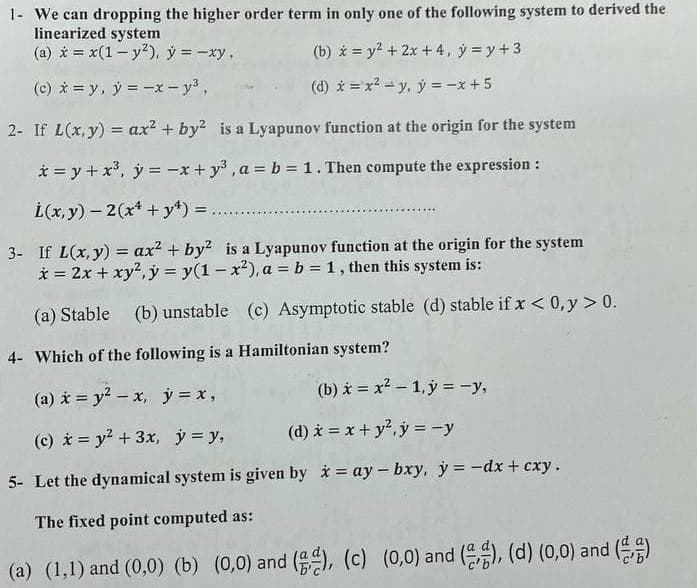4- Which of the following is a Hamiltonian system? (a) x = y² - x, y = x, (c) i = y +3x, j=y, (b)x=x²-1, y = -y, (d) x = x + y², y = -y
4- Which of the following is a Hamiltonian system? (a) x = y² - x, y = x, (c) i = y +3x, j=y, (b)x=x²-1, y = -y, (d) x = x + y², y = -y
Linear Algebra: A Modern Introduction
4th Edition
ISBN:9781285463247
Author:David Poole
Publisher:David Poole
Chapter2: Systems Of Linear Equations
Section2.4: Applications
Problem 27EQ
Related questions
Question

Transcribed Image Text:1- We can dropping the higher order term in only one of the following system to derived the
linearized system
(a) x = x(1 - y²), y = -xy,
(b) x = y² + 2x + 4, y = y + 3
(c) x = y, y = -x- y³,
(d) x = x² - y, y = -x + 5
2- If L(x, y) = ax² + by² is a Lyapunov function at the origin for the system
* = y + x³, y = -x + y3, a = b = 1. Then compute the expression:
L(x, y) - 2 (x² + y) = ......
3- If L(x, y) = ax² + by² is a Lyapunov function at the origin for the system
x = 2x + xy², y = y(1-x²), a = b = 1, then this system is:
(b) unstable (c) Asymptotic stable (d) stable if x < 0, y > 0.
4- Which of the following is a Hamiltonian system?
(a) x = y² - x, y = x,
(b)x=x²-1, y = -y,
(c) i = y +3x, j=y,
(d) x = x + y², y = -y
5- Let the dynamical system is given by x=ay-bxy, y = −dx + cxy.
The fixed point computed as:
(a) (1,1) and (0,0) (b) (0,0) and (d), (c) (0,0) and (2), (d) (0,0) and (2)
Expert Solution
This question has been solved!
Explore an expertly crafted, step-by-step solution for a thorough understanding of key concepts.
Step by step
Solved in 2 steps with 2 images

Recommended textbooks for you

Linear Algebra: A Modern Introduction
Algebra
ISBN:
9781285463247
Author:
David Poole
Publisher:
Cengage Learning

Algebra for College Students
Algebra
ISBN:
9781285195780
Author:
Jerome E. Kaufmann, Karen L. Schwitters
Publisher:
Cengage Learning

Elementary Linear Algebra (MindTap Course List)
Algebra
ISBN:
9781305658004
Author:
Ron Larson
Publisher:
Cengage Learning

Linear Algebra: A Modern Introduction
Algebra
ISBN:
9781285463247
Author:
David Poole
Publisher:
Cengage Learning

Algebra for College Students
Algebra
ISBN:
9781285195780
Author:
Jerome E. Kaufmann, Karen L. Schwitters
Publisher:
Cengage Learning

Elementary Linear Algebra (MindTap Course List)
Algebra
ISBN:
9781305658004
Author:
Ron Larson
Publisher:
Cengage Learning

College Algebra
Algebra
ISBN:
9781305115545
Author:
James Stewart, Lothar Redlin, Saleem Watson
Publisher:
Cengage Learning

Algebra and Trigonometry (MindTap Course List)
Algebra
ISBN:
9781305071742
Author:
James Stewart, Lothar Redlin, Saleem Watson
Publisher:
Cengage Learning